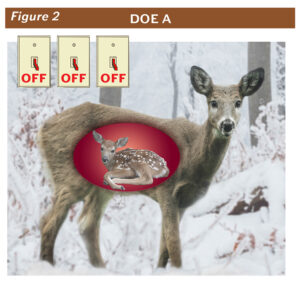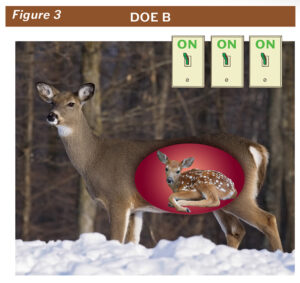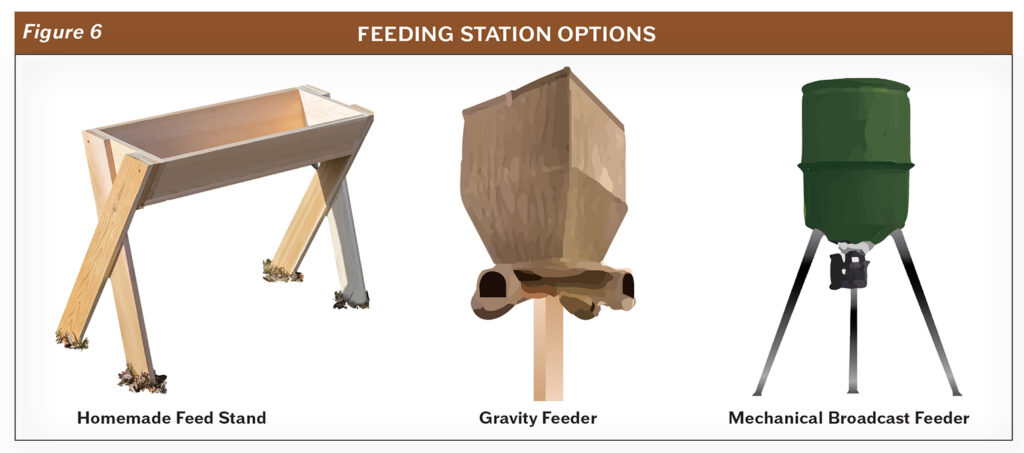Nutrition For Whitetail Does: The Key To Larger Bucks
Click here to view as a pdf: Nutrition for Whitetail Does the Key to Larger Bucks
Whitetail deer hunters across the nation are becoming keyed into the nutritional needs of their local deer population with hopes of producing larger, healthier bucks on their hunting properties. While mineral licks and food plots are popular suggested techniques for supporting antler development, there is little proof of their effectiveness. Recent University research has expanded on an exciting new approach to growing bigger bucks and contrary to conventional methods, it has nothing to do with the bucks at all. The secret involves one word: epigenetics.
What Is Epigenetics?
Epigenetics is a biological phenomenon where certain environmental conditions experienced during pregnancy can switch genes on or off in a growing fetus.1 Once these fetal genes are turned on or off in-utero, that condition stays with the animal for the rest of its life. The concept is simple: if a doe is provided with exceptional nutrition during the winter months when she is pregnant, her offspring will have the potential to exhibit superior physical traits (such as larger antler and body size) later in life.
Epigenetics can be thought of like the action of turning a light switch on or off. When pregnant does meet their nutritional requirements during pregnancy, they are then able to turn on the “switch” (genes) for antler growth, increased body size and improved fertility within their growing fetus (Figure 1). Unfortunately, winter conditions and decreased feed availability coincide with the most critical time of fetal gestation and development. If the pregnant doe does not meet her nutritional requirements during this critical time, her fawn will be born with its “switches” (genes) turned off.
Examples “A” and “B” give two scenarios of how epigenetics can affect deer growth and development
Example A
Doe A is pregnant during a harsh winter (Figure 2). Cold temperatures and deep snow place an increased caloric demand on her and food is scarce. She cannot maintain her body weight and is slowly starving. The hormone profile circulating in her bloodstream is altered to send signals to her growing fetus that the environment it is going to be born into is harsh and unforgiving. There is little food to support growth and development, signaling to the fetus that it will have the best chance of survival if it maintains a small body size; where fewer calories are needed to maintain its weight. If the fetus is a buck fawn, it will be advantageous for it to have smaller antlers because they require less energy to grow. If it is a doe fawn, it will be advantageous for it to have a reduced fertility potential because gestation and lactation are energy-intensive. As a result, the pregnant doe’s circulating hormones will turn off the fawn’s genes for developing larger body size, bigger antlers and increased fertility. Even if this fawn is born into an ideal environment and has abundant food its whole life, the genes (or “switches”) for body size, antler growth and fertility have been turned off. As a result, this deer will develop into an adult that is smaller in stature, with reduced antler size and poor fertility potential.
Doe B is pregnant during the same severe winter as doe A, but feed for doe B is plentiful (Figure 3). This doe’s caloric needs are always met and she is able to maintain her body weight during gestation. The hormone profile circulating in her bloodstream sends signals to her growing fetus that the environment it is going to be born into provides ample food for growth and development. Doe B’s fawn will have to compete with other deer once it is mature so having a large body size, big antlers and increased fertility potential will ensure its genes are passed onto the next generation. As a result, the pregnant doe’s circulating hormones will turn on the fawn’s genes for larger body size, bigger antlers and increased fertility. If this fawn is born into an environment where food is plentiful, its activated genes will allow it to develop into an adult that is larger in stature, with increased antler size and better fertility rates.
The Mineral Lick Myth
There are many myths surrounding deer nutrition in the hunting industry, with one of the most common being that mineral licks help grow bigger antlers. Studies have shown there is little to no scientific evidence that mineral licks produce bucks with bigger antlers. In fact, separate studies completed at Penn State and Auburn University indicate mineral supplementation had no effect on antler size. Both studies tracked two different groups of young bucks. One group of deer was fed a normal diet, while the second group of deer had their feed spiked with minerals. Researchers could find no discernible difference in antler growth between the groups from year to year. In a similar study at Mississippi State, bucks who were supplemented with minerals had an increase in body weight, but antler growth remained the same.2
Research Studies Show How To Grow Bigger Bucks: Applying Epigenetics
The protein demands of wild pregnant does are often not met during the winter months. Mississippi State University explored the hypothesis that providing a protein supplemented diet to wild deer who lived in low-quality forage areas could eventually create hardier, larger, animals in subsequent generations. When protein was supplemented to the gestating does diet, it was shown that their first-generation offspring were up to nine pounds heavier and had an increase in antler size of approximately 6% at three years of age (Figure 4). By the time the second generation of offspring reached three years of age, they averaged up to 29 pounds heavier in body weight than their wild, un-supplemented counterparts and had an increase in antler size of up to 32% (Figure 5).
In a Texas Parks & Wildlife study, wild whitetail bucks were broken into two groups and supplemented over the winter. One group was supplemented with corn and the other group was supplemented with a 16% protein pellet. The 16% protein pellet supplemented herd generated bucks that grew antlers upwards of twice as heavy as the bucks who came from the corn supplemented group (corn only has an 8% protein level). These studies prove that feeding corn and/or minerals alone will not produce larger antler size.3
The “Light Bulb” Moment
The research by Mississippi State University and Texas Parks and Wildlife has turned conventional deer herd management on its head. Up to this point, landowners and hunters have tried to grow bigger bucks by focusing on the bucks themselves with mineral licks and food plots; yielding little to no identifiable results. Epigenetics are what sets the stage for a deer’s potential in life, not the mineral lick or food plot it eats as a mature deer.
The Solution
Crystal Creek® has combined the research done by Mississippi State University and Texas Parks & Wildlife to develop an innovative approach to maximize the genetics of local deer populations. By concentrating on the nutritional requirements of the gestating does during the late fall and winter months, benefits such as improved body condition (including body and antler size) and decreased starve out numbers can be seen. The key is to focus on the fetus (baby buck), growing in-utero. This is what led Crystal Creek® to the product name of Baby Buck®, a supplemental product designed to be fed to the gestating doe to support the baby (buck) growing inside her.
Baby Buck® is a pelleted protein supplement formulated to provide high-quality protein, vitamins and minerals to gestating does (and subsequently the baby bucks in-utero) during the winter months when nutrition can be scarce.
The Baby Buck® program increases the hardiness of local deer populations by offering this high caliber protein supplement to does and fawns when available forage does not meet their nutritional needs. Implementing a winter protein supplement program can improve nutrition for pregnant does and ensure that genes for antler growth, body size and fertility are activated for the next generation of fawns. Baby Buck® helps meet the dietary requirements of gestating does during critical time periods (in utero and during growth phases) to encourage a healthier, more robust deer population that can not only survive the demands of strenuous weather seasons but continue to produce consistently bigger bucks from year to year.
This protein and mineral/vitamin supplement is available in an easy to feed pellet at a recommended feeding rate of ½ to 1 lb. per head per day and can be fed off the ground or through a feeding station (Figure 6). Typical feeder densities used are one feeder for every 100 acres of land being managed. Be sure to comply with all state and federal regulations regarding the feeding of wildlife in your area.
Baby Buck® uses what science knows about epigenetics to give landowners a novel, effective way to provide a long-term management plan for producing larger, healthier bucks and a more vigorous deer population. If you are looking for a proven, science-based method aimed to increase antler size and herd health within your local deer population, contact Crystal Creek® to learn more about this unique approach.







